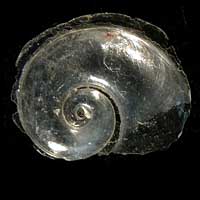|
< Previous family introduction |
|
|||||
 |
Superfamily Pterotracheoidea. Families Atlantidae, Carinariidae, Pterotracheidae Heteropods
|
|||||
|
The superfamily Pterotracheoidea, or heteropods, consists of three families of molluscs that spend their entire existence in the plankton, from just below the sea surface down to hundreds of metres deep. There are about 33 species in the superfamily, which encompasses three families. In the Atlantidae, with 20 species, the shell is relatively large and discoidal, and the animal can withdraw entirely into it. In the Carinariidae, of only 9 species, there is only a small limpet-shaped shell much too small to contain the animal. In the Pterotracheidae, of only 4 species, there is a minute larval shell that does not persist in the adult. The animals of the heteropods are caenogastropod molluscs, with the normal gastropod organs and structures, but modified for a pelagic life. In the Atlantidae the shell, always less than 10 mm, is large compared to the size of the animal, but is thin and lightweight to assist buoyancy. The foot is extended into a fin which is flapped for swimming. In the Carinariidae, shell size is less than 20 mm, but body size can be up to 500 mm in length. The animal is more elongated that in the Atlantidae, and the fin is large and muscular. In the Pterotracheidae, with no shell in the adult, the body is long and cylindrical, up to 320 mm in length, and the fin is large. Heteropods are all very active, mobile carnivores. They have elaborate eyes with good vision which enable them to detect and pursue prey, which are other small animals in the plankton. Food is captured by using the radula with its large, barbed teeth, assisted by a sucker on the foot to hold the prey while it is eaten. Heteropods are of separate sexes, with fertilisation internal. Sperm are packaged into spermatophores which are transferred from male to female. After fertilisation, the female lays eggs, which may be free swimming or attached by gelatinous strings to her own body. These eventually hatch into the water as free-swimming veligers. Heteropods are found in all the tropical and subtropical oceans of the world, between about 40° north and 40° south, although some are restricted to narrow temperature ranges. They do not live on the surface of the sea, as the purple janthinid snails do, but occur from just below the surface to about 500 m. Being pelagic, they are distributed by currents and wind. Some species are distributed world-wide while the others are known from large ocean regions. There have been 25 species collected in Australia (Seapy, Lalli & Wells, 2003). Leslie Newman conducted a study of heteropods collected at 15 sites around Australia, including material collected by the research vessel Kapala off central NSW (Newman, 1990). She identified 18 species of Atlantidae from this region, all rare except for Atlanta peronii which she rated as abundant. The species are listed in Coverage below. Family References
Coverage Only one species of heteropod, Atlanta peronii, is treated in detail here. The following species were found by Newman (1990) to occur rarely and erratically in waters off eastern NSW. She gives distribution maps and figures of shells for some of them.
The following species of Atlantidae are each represented by a few empty shells or shell fragments in the Australian Museum dry shell collection. The localities represent medium and deep water dredge samples, in most cases well outside the known living depth range of the animals.
Identification Notes Atlantid shells are colourless, transparent, flattened coiled shells with a thin flange at the periphery of the last whorl. They are up to about 10 mm in width. Carinariid shells are limpet-shaped, colourless, transparent and fragile, up to about 25 mm in height.
|